It’s that time of the year when I take a look back at some of the best pitches of 2022. Why? Because pitching is the best and GIFs of nasty pitches are the foundation on which Pitcher List was built (and dare I say, AMERICA).
Earlier this month I did an article on the most-chased pitches of 2022, and later I’ll be doing a look at some of the best pitches of each pitch type from last year. But in this article, I’m going to take a look at the pitchers who were throwing nasty pitches that you may not have realized were doing so.
Everyone knows that Gerrit Cole and Max Scherzer and Jacob deGrom and all those guys throw filthy pitches. But for me, it’s fun to take a look at some of the lesser-known pitchers who were also throwing killer pitches.
So we’re going to take a look at money pitches, which are pitches that have:
- at least a 40% chase rate
- at least a 40% zone rate
- at least a 15% swinging-strike rate
Essentially, these are pitches that constantly fooled hitters inside and outside the strike zone. This is now the fifth time I’ve done this article, so if you’d like to take a look at some of the money pitches of the past, click on the links.
There were 25 money pitches thrown last year—here are 12 (featured in alphabetical order) from pitchers that may surprise you.
1. Brady Singer’s Slider
https://gfycat.com/enviouselasticargentinehornedfrog
After a pretty disappointing 2021 that saw him post a 4.91 ERA over 128.1 innings, Brady Singer turned in a pretty impressive 2022, posting a 3.23 ERA and 3.58 FIP with a 24.2% strikeout rate.
A lot of Singer’s success hinged on this slider, as it posted a 40.8% chase rate, 17.2% swinging-strike rate, and a 47.6% zone rate, alongside a 32.9% CSW.
Primarily, Singer throws a sinker and a slider, with those two pitches comprising 92.3% of his pitches thrown last year, and while I tend to get a little nervous about starting pitchers who are two-pitch pitchers, it worked for Singer because both his slider and sinker were pretty darn good.
The sinker was effective at inducing weak contact, with opposing hitters posting a .311 wOBA and .313 xwOBA against the pitch, and when that’s combined with a primo strikeout pitch like his slider, it works out.
However, it’s not all good news with Singer, as some of his peripherals suggest he benefitted from some good fortune last year (like his 79.6% left on base rate). Singer’s third pitch he’d throw some of the time was a changeup, and while hitters had a .265 wOBA against it last year, that came with a .425 xwOBA. And on top of that, Singer’s 3.23 ERA came with a 3.97 xERA.
2. Braxton Garrett’s Slider
https://gfycat.com/pastunluckybluetonguelizard
Braxton Garrett has carried the “top prospect” label basically ever since he was drafted with the seventh-overall pick by the Marlins in 2016, and his first season getting a few consistent starts was … not so great.
That’d be 2021, where he started seven games to the tune of a 5.03 ERA, a 20.1% strikeout rate, and a 12.6% walk rate. As I said, not great.
But 2022 was different, luckily. Garrett started 17 games and posted a 3.58 ERA alongside a 3.56 FIP with a much improved 24.1% strikeout rate and 6.4% walk rate.
So what changed? Garrett started using his pitches differently. In 2021, he went with a mix of fastball 35.3% of the time, slider 21% of the time, curveball 18.1% of the time, changeup 12.9% of the time, and sinker 12.8% of the time.
But in 2022, he made his slider his primary pitch, throwing that 32.1% of the time and dropping his fastball usage to 24%. The sinker increased to 23.6%, and the curveball and changeup also saw drops.
And using that slider worked out great. The pitch was a great strikeout pitch, posting a 45.8% chase rate, 20.7% swinging-strike rate, 42.7% zone rate, and a 36% CSW. Meanwhile, the fastball got way better at inducing weak contact. In 2021, the pitch had a .429 xwOBA against it, but in 2022, that dropped to a .387 xwOBA (which, admittedly, isn’t great but it’s an improvement).
It remains to be seen where Garrett fits into the Marlins’ rotation or bullpen next year (or if he’s in the majors at all), but if this slider continues being the excellent pitch that it is, he’ll at least rack up some strikeouts.
3. Carlos Carrasco’s Slider
https://gfycat.com/dearestcostlyhart
So here’s something fun — Carlos Carrasco isn’t just on this list, he was on my list of the most-chased pitches of 2022 as well. And he wasn’t just on that list once, he was on it twice. In the five years I’ve been doing that article, a pitcher has had two pitches among the top 10 most-chased in the league only one other time. And that was in 2018 when Carlos Carrasco did it.
So yeah, Carrasco’s pretty good, and if you know the story with Carrasco, it’s his slider and changeup that are his bread and butter. They’re killer pitches, and this slider was no different. Not only did it have the 10th-best chase rate in baseball last year at 45.3%, but it also posted an 18.9% swinging-strike rate, a .266 wOBA against, and a .113 ISO against.
But again, if you’re familiar with Carrasco, you know what’s holding him back too — his fastball. That’s been the story with Carrasco his whole career, an incredible slider and changeup and a terrible fastball, and last year was no different. In 2022, opposing hitters had a .400 wOBA and .213 ISO against his fastball, a pitch he threw over 850 times. Yuck.
4. Jesús Luzardo’s Changeup
https://gfycat.com/anchoredsardonicadder
Jesús Luzardo looked pretty darn good last year, pitching the most innings he’s thrown in an MLB season so far, posting a 3.32 ERA with a 3.12 FIP through 18 starts and 100.1 innings alongside a 30% strikeout rate.
Luzardo has some pretty nasty stuff, and that changeup is chief among them. PLV especially likes the changeup, take a look:
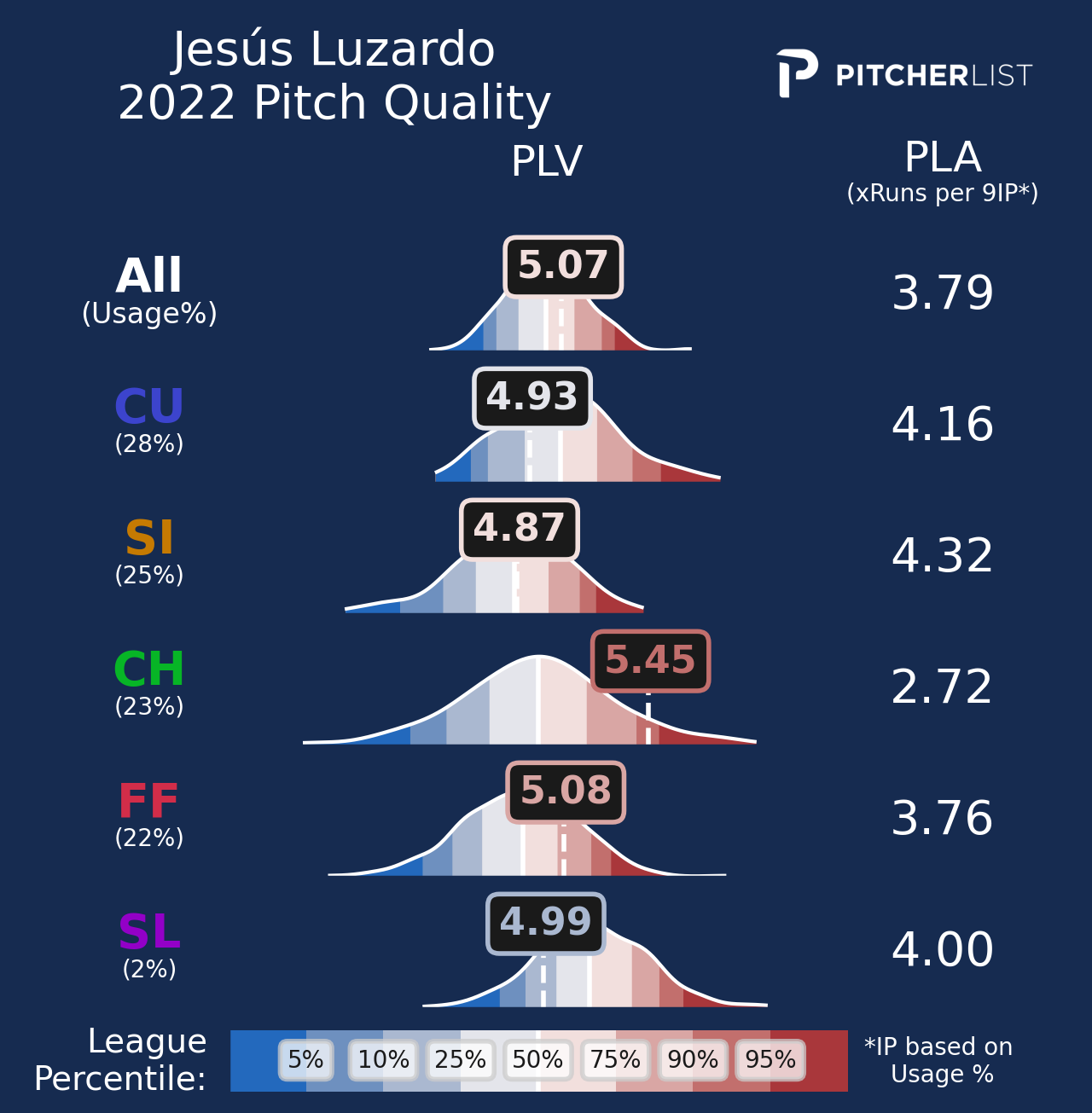
While most of Luzardo’s arsenal comes out around average or slightly above average, that changeup is among the best in the game (in fact, it ranked as the 19th-best changeup by PLV among all changeups last year).
The pitch posted a 41.2% chase rate, 25.4% swinging-strike rate, 44.9% zone rate, and a 35.8% CSW alongside a .270 wOBA and .108 ISO against. I mean, pick a metric, Luzardo’s changeup was fabulous in it.
As for the rest of his arsenal, his fastball was solid at inducing weak contact, as opposing hitters had just a .280 wOBA against it (though he had some command issues as they also posted a .188 ISO against it) and his curveball (or slider, depending on what site you’re on) worked pretty well as a swing-and-miss pitch, posting a 32.6% chase rate and 16.8% swinging-strike rate.
The key for Luzardo is honestly health. He’s had some injury issues in the past and last year was no different. While he was able to get through 18 starts last year, until he can get through a full season, he’s going to be a risk in fantasy. But the nasty stuff is there.
5. JT Brubaker’s Slider
https://gfycat.com/negligiblesourdoctorfish
So this is a fun one that I wasn’t really expecting to see. JT Brubaker did not have a great year last year. He spent another full year in the Pirates’ rotation, starting 28 games and pitching 144 innings, posting a 4.69 ERA (albeit with a 3.92 FIP) alongside a 1.47 WHIP and a 22.8% strikeout rate.
But if there’s a bright spot for Brubaker, it’s this slider. Last year, Brubaker’s slider posted a 40.6% chase rate, 22.2% swinging-strike rate, 43.7% zone rate, and a 33.6% CSW. It was a great swing-and-miss pitch, and while opposing hitters had a .326 wOBA against the pitch last year (which is around league average, so solid), they also posted a .177 ISO against it. So in other words, the pitch was generally either a swing and a miss or it got crushed.
Brubaker also threw a curveball last year and it worked decently as a swing-and-miss pitch, posting a 37% chase rate, 13.4% swinging-strike rate, and a 34.9% CSW. There’s definitely potential there, but what brings Brubaker down a bit is his sinker, which opposing hitters had a .359 wOBA against last year.
All of that being said, aside from his two least-thrown pitches (which I’m not too concerned about), the PLV of his repertoire floats around league average or better:
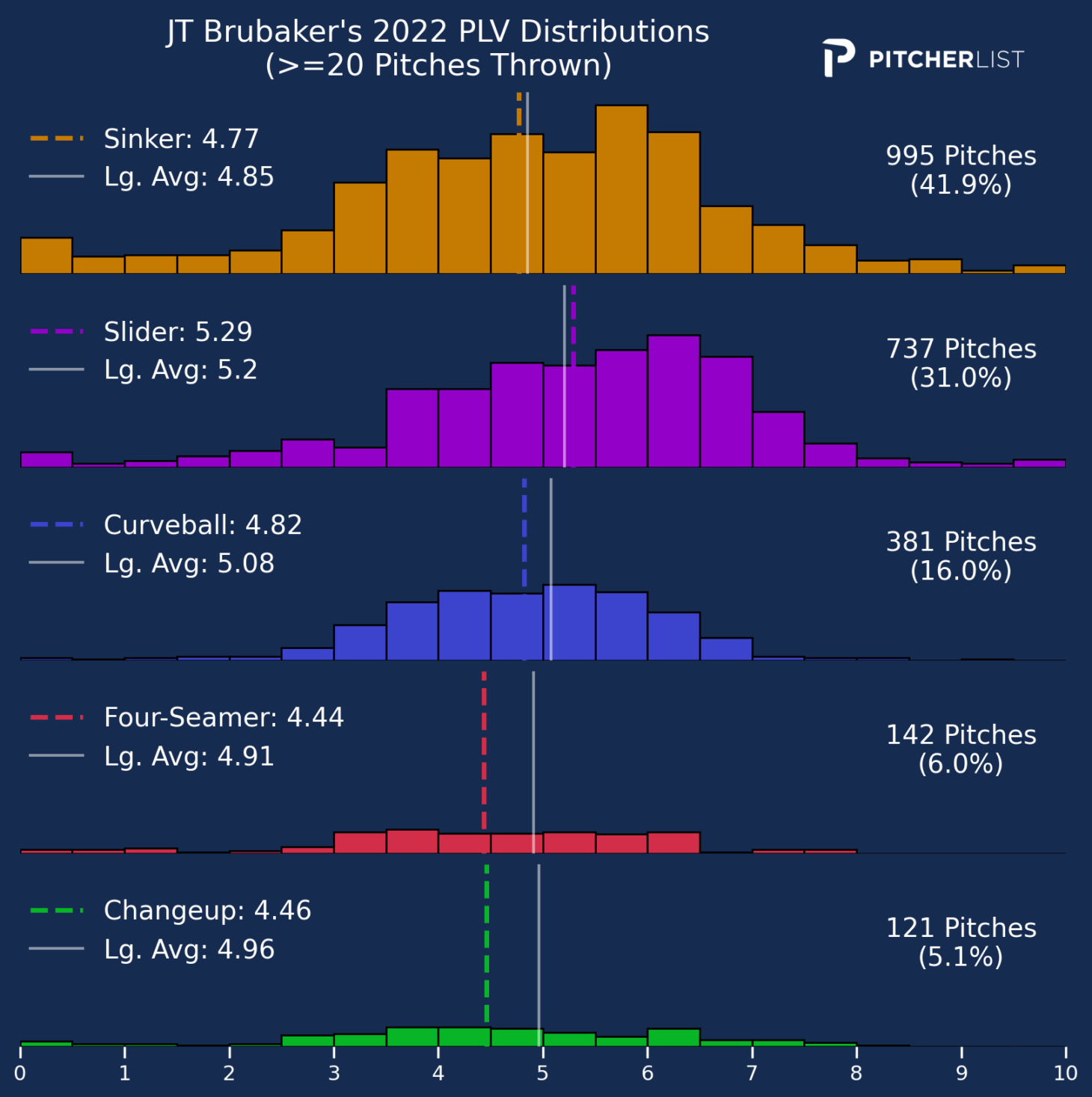
Considering the swing-and-miss stuff that he brings with his slider and curveball, there’s definitely potential here, and I’m very curious to see where he goes.
6. Nathan Eovaldi’s Splitter
https://gfycat.com/dentalhappybackswimmer
Last year, Nathan Eovaldi turned in his third-straight season posting an ERA below 4.00, pitching 109.1 innings through 20 starts with a 3.87 ERA and a 22.4% strikeout rate.
Eovaldi had some injury problems throughout the year but generally speaking, he looked pretty solid, and this splitter was probably the best pitch in his repertoire, as it posted a 47.9% chase rate, 22.6% swinging-strike rate, 40.2% zone rate, and a 31.6% CSW. And even when hitters made contact with Eovaldi’s splitter, they didn’t do much with it, posting just a .197 wOBA and a .048 ISO against the pitch.
Now, something important to note with Eovaldi—that 3.87 ERA he had last year came with some concerning peripherals. Specifically a 4.30 FIP and a 4.31 xERA.
Still, when you look at Eovaldi’s repertoire, there’s a lot to like, especially from a PLV perspective:
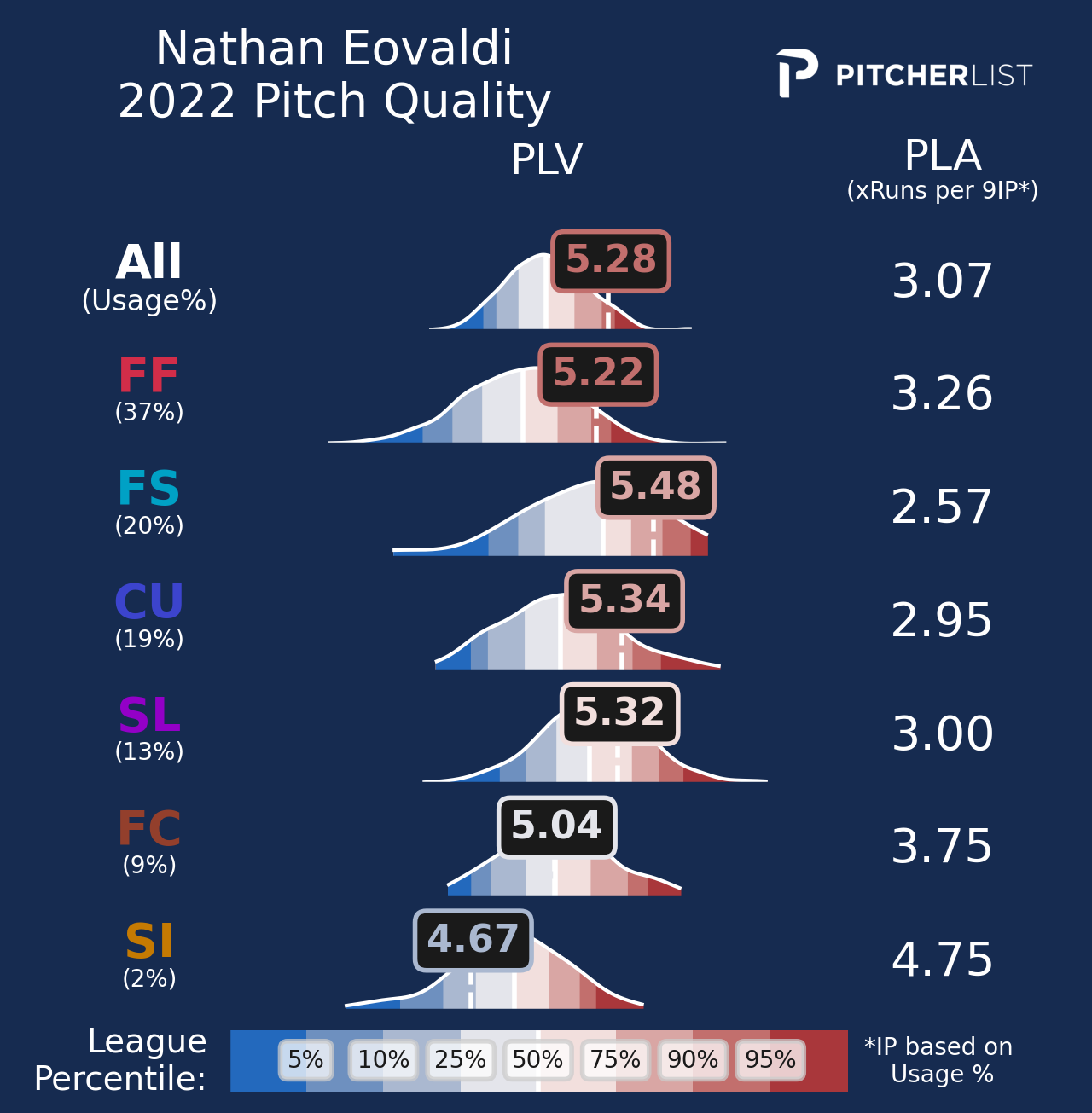
We’ve already established that he’s got a fabulous splitter, but he’s also got a curveball that works pretty well too, posting a 33.5% chase rate, 15.6% swinging-strike rate, and 35.1% CSW last year.
The fastball is where Eovaldi got hurt last year. He lost a couple of ticks in velocity, dropping it from an average of 97.1 MPH in 2021 to 95.9 MPH last year, and it got knocked around a good bit, as opposing hitters had a .376 wOBA and .217 ISO against the pitch.
Still, we’ve seen Eovaldi be very good in the past, and he’s got a solid arsenal of pitches. He’s going exceptionally cheap in drafts (as of this writing, his NFBC ADP is 237), so he’s definitely worth a flier at the end of your fantasy draft.
7. Patrick Sandoval’s Slider
https://gfycat.com/saneinfamouskitten
We finally got a full season out of Patrick Sandoval and it was pretty great. The 26-year-old posted a 2.91 ERA with a 3.09 FIP in 27 starts and 148.2 innings, and the best part of it all? He did it using a breaking pitch and an off-speed as his primary pitches.
I’ve got nothing against pitchers who do the traditional approach of having your fastball as your primary pitch and complementing it with breaking pitches and/or off-speed pitches, but there’s something fun for me about a guy who pitches backwards and has success doing it. It’s a viable approach and I wish more pitchers would do it.
Sandoval is one of those guys. This slider was his primary pitch last year and with the numbers it produced, why wouldn’t it be? The pitch garnered a 40.3% chase rate, 17.9% swinging-strike rate, 31.8% CSW, and a 51.1% zone rate. And on top of that, opposing hitters had just a .233 wOBA and .061 ISO against the pitch.
It’s a killer pitch that Sandoval used early in the count pretty frequently but also was able to use it in two-strike counts to get strikeouts.
But wait! There’s more! Sandoval’s second most-thrown pitch was his changeup, which posted a 39.9% chase rate, 23.3% swinging-strike rate, and a 30.4% CSW, alongside a .265 wOBA and .074 ISO against.
And when you look at what Sandoval’s fastball did, which was a .441 wOBA and .189 ISO against, you can see why he decided to primarily go with his slider and changeup. The question is, can Sandoval maintain his success with a garbage fastball that he chooses not to throw as much?
One potential solution: utilizing his sinker more than his four-seam. That four-seam was bad, but the sinker posted a .280 wOBA and .039 ISO against. So perhaps Sandoval could ditch the four-seam altogether and instead work with his sinker?
Either way, I think if he continues using his slider and changeup as his primary pitches, those will help deaden the blow of how bad his fastball can be, and I think a good bit of the success we saw last year could easily continue into this year.
8. Ross Stripling’s Changeup
https://gfycat.com/variableimpossibleguineafowl
Another guy who was on my most-chased pitches article, I’ve been hyping up Ross Stripling as a potentially valuable fantasy starter for a bit now, and I’m very curious to see what he does this year.
Stripling spent most of his time in a bullpen role for the Blue Jays in 2020 and 2021 and did not have a good time, posting an ERA of 5.84 and 4.80 in those seasons, respectively.
But last year, Stripling turned things around and posted a 3.01 ERA, 3.11 FIP, and 3.57 xERA through 134.1 innings thanks in large part to a change in his pitch mix:
Back on the Ross Stripling thing cause why not
A reason I'm really interested in his potential – look at the changes between 2021 and 2022
FB is about the same but started using the CH more (which was really good!) and his SL more, decreasing his CB usage pic.twitter.com/kEzAKsUR41
— Ben Palmer (@benjpalmer) January 31, 2023
Stripling cut down on his much he was using his fastball (which was not a very good pitch), basically ditched his curveball, and focused more on throwing his changeup and slider.
And as I’m sure you can guess based on the fact that his changeup is on his list, it worked out pretty darn well, posting a 46.7% chase rate, 20.9% swinging-strike rate, and a 41.7% zone rate alongside a .244 wOBA against.
The slider worked out pretty well too. It wasn’t so much a swing-and-miss pitch, but it did a good job at inducing weak contact, posting a .218 wOBA and .035 ISO against. If this change sticks this year and Stripling gets a full-time gig in the Giants’ rotation, I think there’s definitely some potential here.
9. Taijuan Walker’s Splitter
https://gfycat.com/helpfulexaltedindigobunting
Taijuan Walker has had an odd last few years. He looked great in 2017 with Arizona, posting a 3.49 ERA through 157.1 innings, but that ERA came with some scary peripherals, including a 4.99 FIP and 4.37 xERA. Then, he misses the majority of 2018 and 2019 thanks to Tommy John surgery, finally coming back in 2020 with the Mariners.
Then, with the Mariners (and the Blue Jays after being traded) in the shortened 2020 season, Walker looks great again, posting a 2.70 ERA over 53.1 innings but, again, with concerning peripherals, including a 4.56 FIP and 5.00 xERA.
Then we get Walker on the Mets in 2021, he posts a 4.47 ERA and a 4.57 FIP over 159 innings, seemingly in line with where his peripherals have been at the past few years. But then he turns things around in 2022 posting a 3.49 ERA through 157.1 innings. And stuff like his FIP and xERA? At 3.65 and 3.94, respectively.
So what in the world is going on with Taijuan Walker?
Well, on the one hand, we’ve had some pitch mix changes over the years. In 2022, Walker threw his fastball just 29.4% of the time after throwing it 34.9% of the time in 2021 and 37.7% of the time in 2020. Meanwhile, in 2022, he increased the usage of his splitter significantly while decreasing the usage of his slider and sinker, and slightly increasing how much he used his curveball.
The splitter is really the key here. Last year, the pitch posted a 43.4% chase rate, 15.5% swinging-strike rate, and a 43.9% zone rate alongside a .227 wOBA and .072 ISO against. By PLV, it’s easily the best pitch in his arsenal (and basically the only one that isn’t at or below league average):
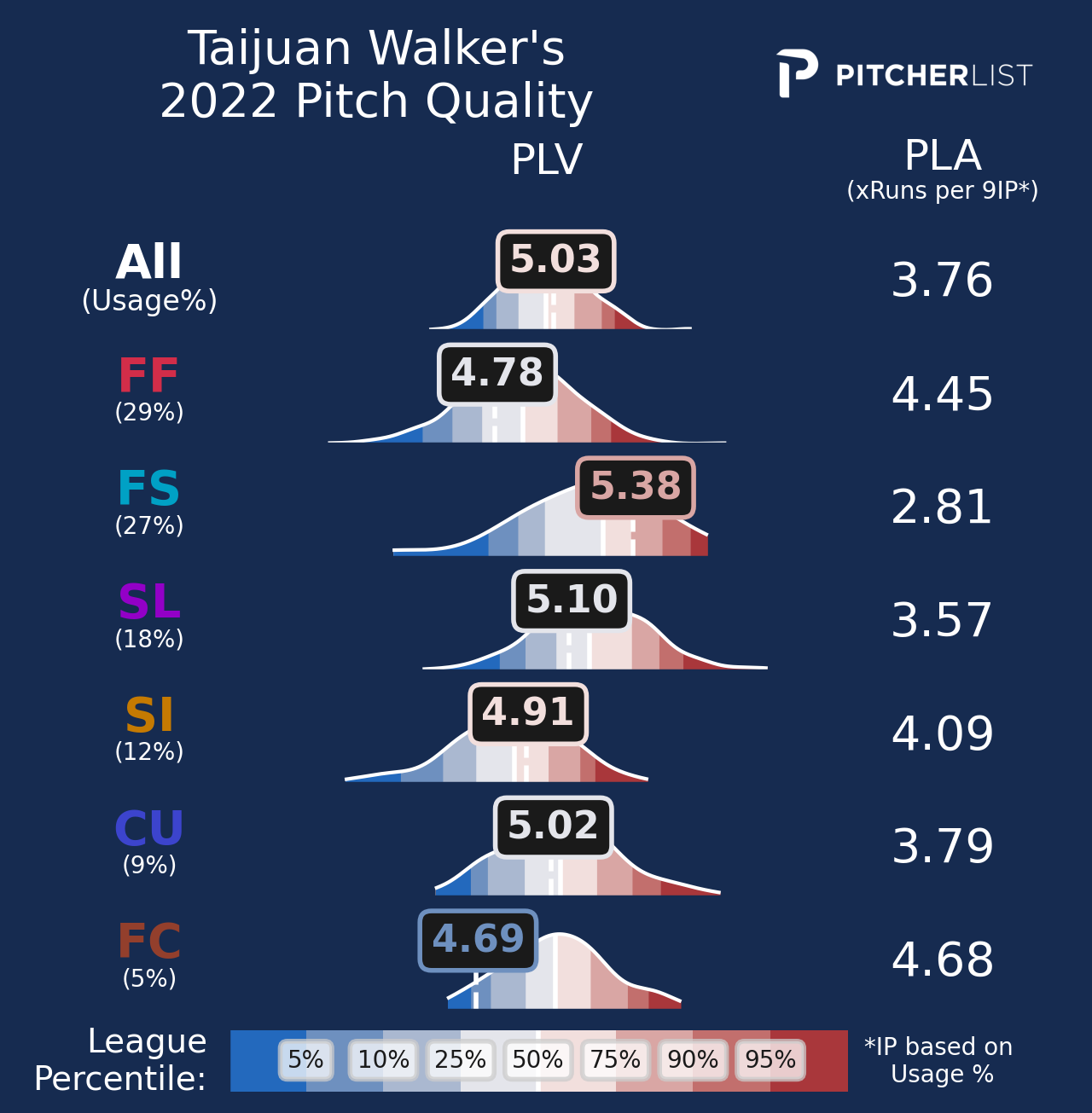
It worries me when a pitcher’s entire repertoire is average or bad save for one pitch. His fastball, which was still his most-thrown pitch, posted a .354 wOBA and .203 ISO against. That’s not great. And none of his other pitches outside the splitter were particularly good at inducing swings and misses.
He’s a guy that worries me. I worry that the best-case scenario for Taijuan Walker is he posts a mid-3s ERA with low strikeout numbers, basically what he did last year, and is that someone who’s going to help you win a fantasy championship? I’m not sure it is.
10. Tony Gonsolin’s Splitter
https://gfycat.com/embarrassedwavyfieldmouse
We finally got a full year of starting out of Tony Gonsolin last year and he did not disappoint, posting a 2.14 ERA with a 3.28 FIP through 130.1 innings.
A large part of that success came from this splitter, which posted a 42.7% chase rate, 18.7% swinging-strike rate, and a 47.2% zone rate alongside a .147 wOBA and .089 ISO against. It was a killer pitch, and that, mixed with his slider, which posted a solid 33.6% chase rate and 18.3% swinging-strike rate alongside a .195 wOBA against, made for two very good secondary pitches.
If there’s a weak point, it’s his fastball, which hitters had a pretty nasty .212 ISO against, but if you’ve got quality secondary pitches, you can make a bad fastball workable. Still, alongside that not-great fastball, PLV seems to think Gonsolin’s pitches might not be all they were cracked up to be:
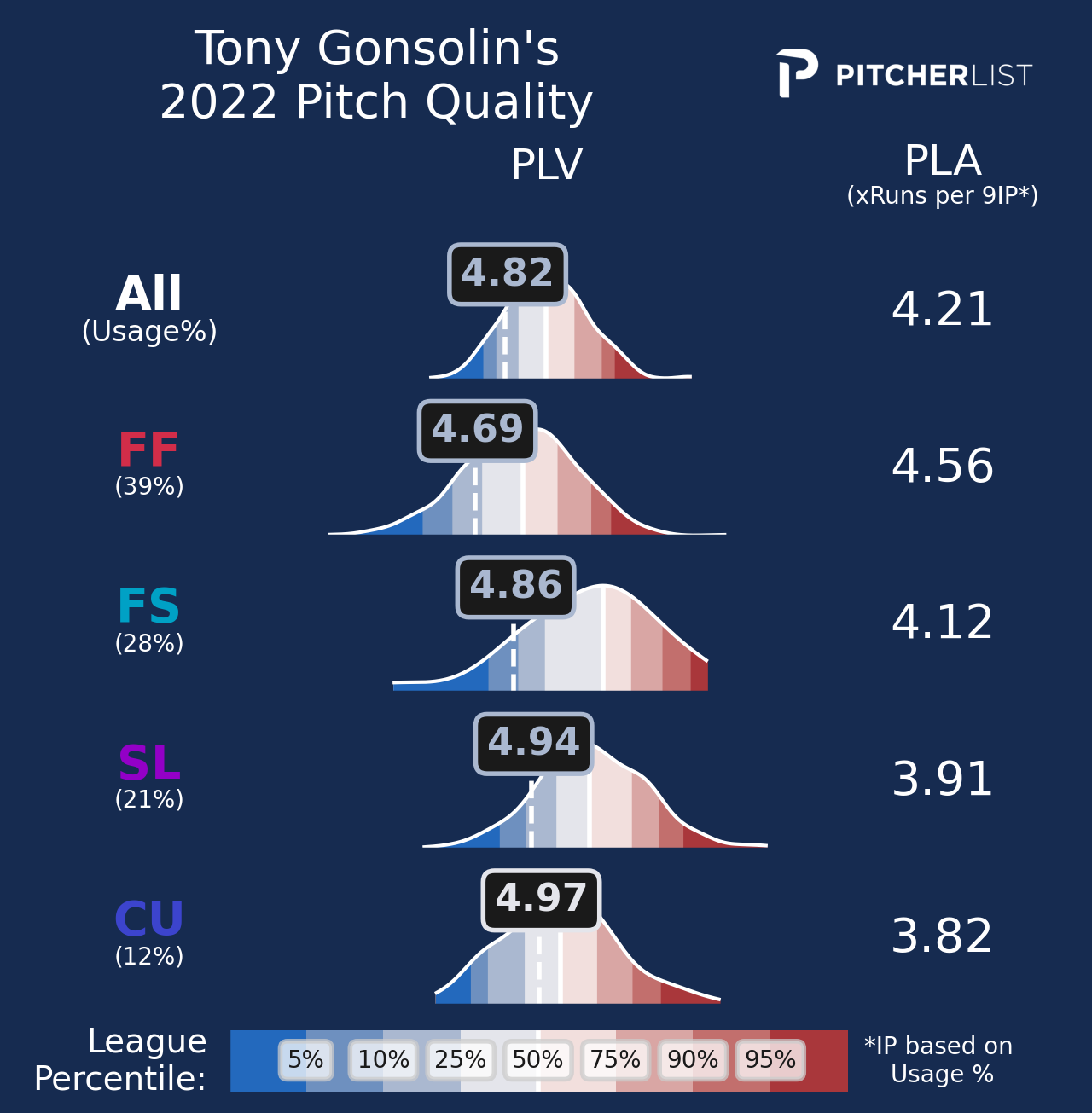
Obviously, that’s far from a guarantee that Gonsolin will suddenly implode next year, but it is something worth noting.
11. Yusei Kikuchi’s Slider
https://gfycat.com/naturalthoroughinchworm
Another member of the most-chased pitches list! If there’s one thing that is consistently good about Yusei Kikuchi each year, it’s his slider. It was one of the 10 most-chased pitches of 2021 and again in 2022 and it’s a fabulous pitch.
Last year, the pitch posted a 47.3% chase rate, 19.2% swinging-strike rate, 53% zone rate, and a 33.9% CSW. A great swing-and-miss pitch. The problem? It also gets crushed. Last year, opposing hitters posted a .414 wOBA and a .322 ISO against his slider, likely in part because Kikuchi has a habit of locating the pitch right over the heart of the plate, which he did 9.4% of the time last year, way above the MLB average of 5.9%.
Kikuchi’s fastball isn’t great either, the pitch had a .390 wOBA and a .243 ISO against the pitch, and as long as Kikuchi is putting up those kinds of numbers, he’s going to be one of those guys who’s got one killer strikeout pitch but not the consistent success you want to see.
12. Zach Plesac’s Slider
https://gfycat.com/dearcooldore
Zach Plesac is sort of similar to Yusei Kikuchi in a way. He’s another guy who has struggled but has this one killer pitch in his slider, and last year was no different.
In 2022, Plesac posted a 41.2% chase rate, 20.4% swinging-strike rate, 31.1% CSW, and a 44.4% zone rate alongside a .257 wOBA and .128 ISO against. So unlike Kikuchi’s, Plesac’s slider is great all around. But last year was not a great year for him, as he posted a 4.31 ERA with a 4.45 FIP and 5.28 xERA alongside a 17.6% strikeout rate through 131.2 innings, a year not too unlike 2021.
So what’s the issue with Zach Plesac? Well, for one, his fastball isn’t great. Averaging about 92 MPH, the pitch had a .390 wOBA and .197 ISO against last year, it was eminently hittable. And while he’s got this great slider, he has really nothing else of note in his repertoire. In fact, take a look at his PLV chart, it’s rough:
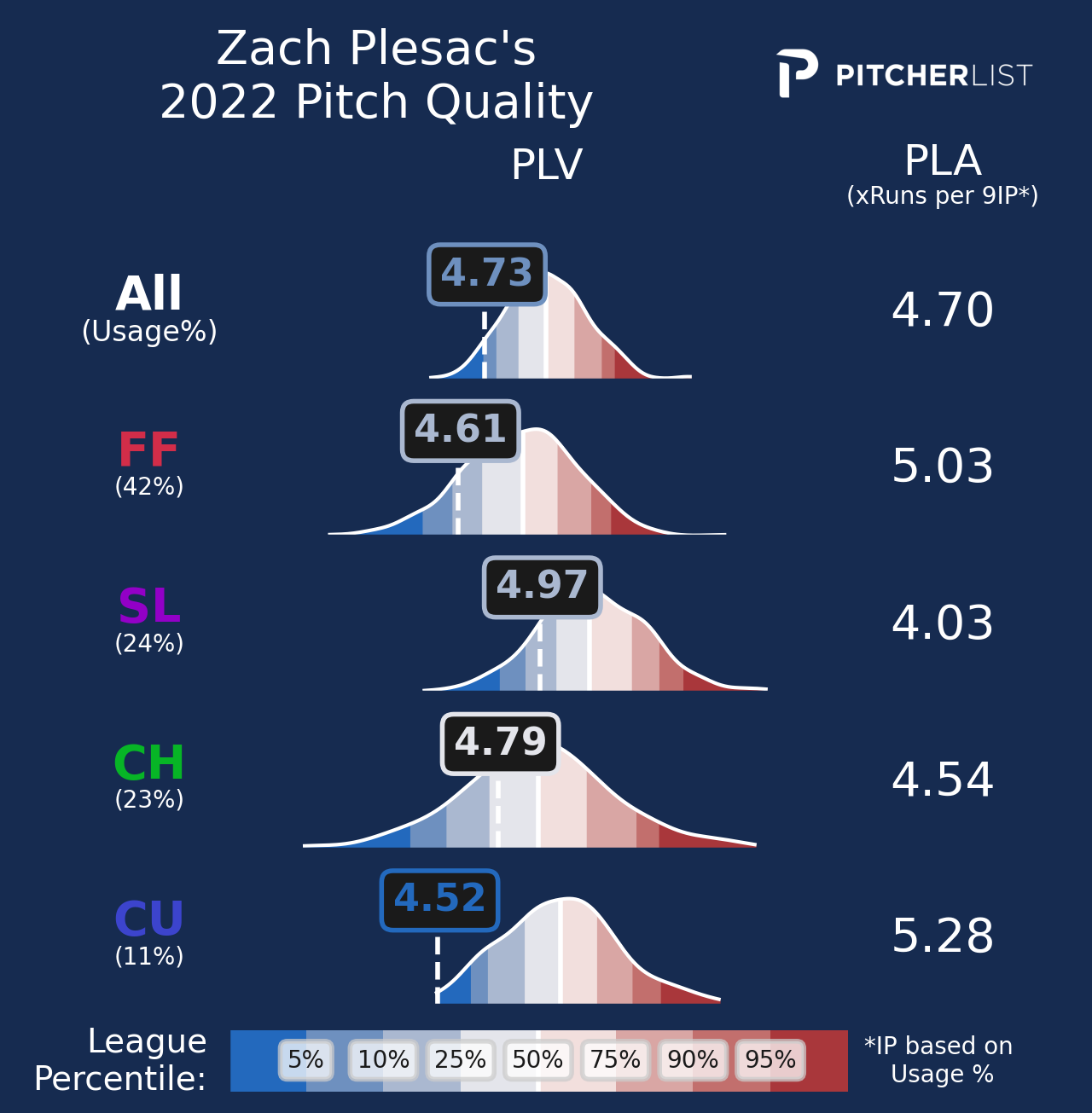
The slider is his best pitch and even that is pretty below average from a PLV perspective. Plesac’s just not a guy (so far) who’s going to rack up much in the way of strikeouts and isn’t going to be consistently reliable. But hey, he’s got a pretty sweet slider, so at least he’s got that going for him.
Photos by Ian D’Andrea (https://www.flickr.com/people/idsportsphoto/) and Icon Sportswire | Adapted by Justin Paradis (@JustParaDesigns on Twitter)

